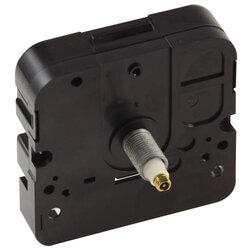+1 888 123 4567
Clock Motors and Getting one of the most from Them

Clock motors are what manage the functioning of conventional timepieces. Modern clock motors ("activities" is the term frequently used in the profession) ascertain their timing from the number of pulses emitted by a quartz crystal (at a high and specific resonant regularity) taking place over a specific duration; via counting and subdivision (in software) they can after that acquire instantaneous angles of turning for each of the hands. Nevertheless, though timekeeping is one of the most fundamental capability of these devices, they can do so much a lot more, exhibiting functions ranging from traditional to unique to idiosyncratic.
Early clock motors worked mechanically. Prospective power in the form of curled springtimes or hanging weights was exchanged the kinetic energy of a rotating flywheel, the speed of which could be controlled with the collaborated combination of pendulum and escapement. By delicately readjusting the specifications of this mix (e.g., size of pendulum shaft) the clockmaker was able to achieve a consistent tick at the highly exact rate of one secondly.
In time the mechanical structures were replaced by electronic ones, much less burdened with cumbersome components. Quartz crystals ended up being the power source, producing pulse trains at gradually precise frequencies when voltage is put on them. Pulse matters could be accumulated in digital signs up, and software transformed the pulse streams right into time markers of hours, minutes, and seconds.
Some historical wrist watches exhibited spectacular effects (along with conventional timekeeping) that were produced through painstaking and intricate layout job coupled with ingenious mechanical combinings. Such traits can be simulated with the modern digital clock activities in a relatively uncomplicated way via software. Yet it is additionally possible to achieve also better results, nearly anything the imagination can dream up, because programs is much more adaptable than mechanical engineering.
We have actually all seen watches and other type of wrist watches extend average timekeeping by showing the stage of the moon, the day of the week, or the day of the month. Electronic electric motors do any one of these and extra, consisting of 24-hour cycles. Unique dials and extra hands might be required, yet the software program manages it all.
For mechanical clocks, weight dimension, coil stress, and torque called for to turn the flywheel were all part of the overall style. For quartz clocks, motors are developed to manage a range of clock sizes, but it would be a waste of power to cover the entire range with a solitary electric motor. For this reason, you will certainly discover conventional motors able to revolve hands appropriately for all clocks approximately about 14" in diameter, and "high-torque" variations for bigger sizes.
Ticking second hands are artifacts of mechanical clock style because escapements (which regulated pendulum timing) audibly oscillated as soon as a second. Yet electronically this is no more needed, and clock electric motors are available that present a continuous sweep activity that is also quiet.
By configuring the activity to operate a cycle of 1 day plus 50 mins (instead of, or in addition to, the 12-hour or 24-hour cycle), it will track the motion of the tide, which can be convenient for littoral residents. Also offered are movements that track weather sensations, such as temperature level and moisture. In this situation, sensing units are called for to determine the existing value frequently, and the electric motor transforms it to a (single) hand position superimposed over an adjusted dial.
You will find clock electric motors that supply accessories, a number of which imitate treasure functions. For example, it may play chime melodies and hour matters, or oscillate a purely cosmetic pendulum.
Abilities of Swiss clockmakers are epic, enabling them to create outstanding mechanical timekeeping marvels. The modern-day clockmaker doesn't need the exact same degree of ability yet he can create digital tools that are similarly excellent. It just takes understanding clock motors and obtaining the most from them.